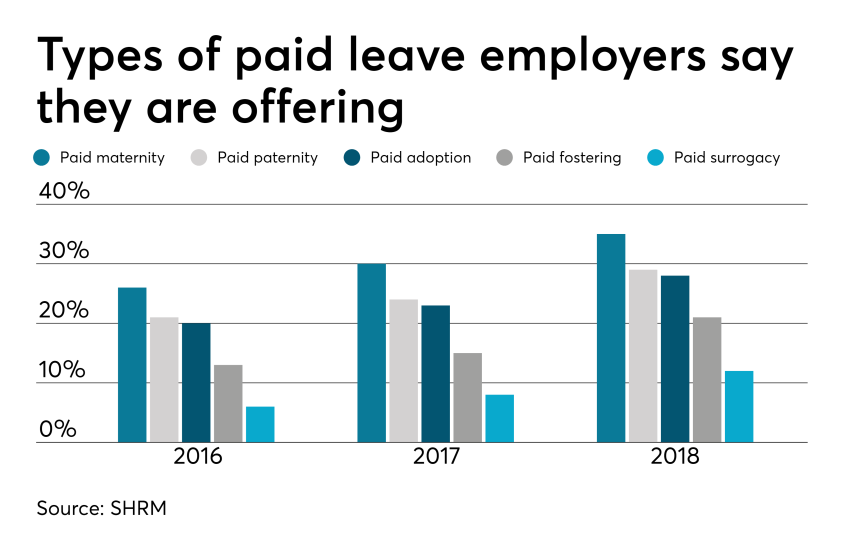4 pitfalls of paid leave and how clients can avoid them
Employers are using paid leave options to help boost their employee benefits packages in efforts to better attract and retain talent. Read the following blog post from Employee Benefit Advisor for 4 common pitfalls of paid leave and how employers can avoid them.
 Smart employers are boosting their benefits packages with paid family leave — the most coveted work perk among all generations. In today’s low unemployment environment, paid leave benefits can be a huge differentiator in attracting and retaining talent.
Smart employers are boosting their benefits packages with paid family leave — the most coveted work perk among all generations. In today’s low unemployment environment, paid leave benefits can be a huge differentiator in attracting and retaining talent.
But some employers are getting themselves into trouble in the process, facing accusations of gender discrimination or improper use of leave.
Here are four potential pitfalls of paid leave, and how employers can avoid them.
1. Be careful what you call “maternity leave.”
Employers have long been granting leave for new moms in the form of disability coverage. In fact, the top cause of short term disability is pregnancy. Disability insurance usually grants new moms six to eight weeks of paid leave to recover from childbirth.
Because this coverage applies to the medical condition of recovering from childbirth, it shouldn’t be lumped in with bonding leave.
Guidance from the Equal Employment Opportunity Commission says leave granted for new moms for bonding must also be extended to new dads, so separating disability leave from bonding leave is crucial to avoiding gender discrimination.
2. Don’t make gender assumptions.
The amount of bonding time for new parents after birth, adoption or fostering must be granted equally for men and women. Companies that don’t provide the same amount of paid leave for men and women may find themselves in a discrimination lawsuit.
It’s not just the time away from work that matters, but also the return-to-work support provided. If new moms are granted temporary or modified work schedules to ease the transition back to work, new dads must also have access to this.
Some companies may choose to differentiate the amount of leave and return-to-work support for primary or secondary caregivers. That’s compliant as long as assumptions aren’t made on which gender is the primary or secondary caregiver.
The best way to avoid potential gender discrimination pitfalls is to keep all parental bonding and related return-to-work policies gender neutral.
3. Avoid assuming the length of disability.
Be careful about assuming the length of time a new mom is disabled, or recovering medically, after birth. Typical coverage policies allot six to eight weeks of recovery for a normal pregnancy, so assuming a new mom may be out for 10 weeks might be overestimating the medical recovery time, and under-representing the bonding time, which must be gender neutral.
4. Keep up with federal, state and local laws.
Mandated leave laws are ever-evolving, so employers should consistently cross-check their policies with state and local laws. For instance, do local paid leave laws treat adoption the same as birth? Are multistate employers compliant? What if an employee lives in one state but works in another: Which state’s leave policies take precedence?
Partnering with a paid leave service provider can mitigate the risk of improperly administering leave. Paid leave experts can help answer questions, review guidelines and provide information regarding job-protecting medical or family leave.
They can also help flag potential pitfalls, ensuring leave requests from all areas of your company are managed uniformly and in accordance with state and federal laws, including the EEOC.
SOURCE: Bennett, A. (12 September 2019) "4 pitfalls of paid leave and how clients can avoid them" (Web Blog Post). Retrieved from https://www.employeebenefitadviser.com/list/4-pitfalls-of-paid-leave-and-how-clients-can-avoid-them
Netflix exec: To boost diversity, employers must improve benefits
Are you implementing specific employee benefits in an effort to boost diversity and inclusion at work? According to Vice President of Inclusion Strategy at Netflix, Verna Myers, Implementing the right employee benefits could help employers boost workplace diversity and inclusion.
NEW YORK — Employers still have a long way to go when it comes to fostering diversity and inclusion at work — but implementing the right benefits could be a step in a positive direction.
That’s according to Vernā Myers, vice president of inclusion strategy at Netflix, who said companies should focus on rolling out new benefits that help employees at different life stages. While perks like free lunch are nice, they aren’t going to keep workers around long term, she said at a meeting with reporters Wednesday.
“It’s more about [having] a kind of system that acknowledges real life and what people’s needs are,” she said. “That builds a certain kind of loyalty and trust.”
So what should employers focus on? Myers said employees want holistic benefits that address life changes, including starting out careers and parenthood. Mental health and financial benefits also should be a priority.
So far, tech companies, startups and other progressive employers are doing this well. “Companies have realized they’re part of a life ecosystem, and that makes a big difference,” she added.
But employers may still have a long way to go. Myers, who is a Harvard trained lawyer, said she has heard of instances where male employees faced discrimination for taking advantage of benefits like paternity leave. Meanwhile, offerings like maternity leave have not always been industry standard, she said.
“People still don’t remember that we did not have maternity leave,” Myers said, recalling a conversation with a partner at a law firm who used three weeks of vacation time when she had her baby.
Myers said she has overwhelmingly found that while organizations are interested in bringing in more diverse workers, they often won’t make adjustments to benefits and culture in order to better accommodate these employees. Employers “were unwilling to do much of anything to adjust to the fact that they were inviting difference,” she said.
Survey data from PwC suggests that diversity and inclusion is a high priority for employers, but many can still do more to improve their programs. A full 74% of employers said diversity and inclusion is a priority at their company. But the consulting firm found that only 5% of the programs were reaching their full maturity when assessed against PwC’s model, which reviews factors including strategy and engagement.
But employers have shown interest in adding more inclusive benefits. Some — like Hewlett Packard Enterprise and Hilton — have invested in family-friendly offerings like expanded paid parental leave and breast milk shipping. Others are adding student loan repayment programs and coaching benefits.
Susan Eandi, the head of Baker McKenzie’s global employment and labor law practice in North America, said employers need to focus on employee engagement in benefits if they want to improve diversity and inclusion. As Generation Z enters the workforce, companies may see a shift toward stability. Unlike their millennial counterparts, who spearheaded flexible schedules and gig work, Gen Z workers are more cautious and want security in their jobs and benefits.
“They’re very cautious, concerned individuals who want financial security,” she said. “It will be a big shift for employers.”
Regardless, Myers said companies should continue to create safe spaces for all perspectives and backgrounds to influence decision making. “If employers allow for more opportunity and for people be treated more fairly, then everyone is going to benefit,” she said.
SOURCE: Hroncich, C. (15 May 2019) "Netflix exec: To boost diversity, employers must improve benefits" (Web Blog Post). Retrieved from https://www.benefitnews.com/news/netflix-to-boost-diversity-employers-must-improve-benefits
Changes are coming to paid leave. Here’s what employers should know
Many states and local governments are enacting their own paid leave policies, making it difficult for employers to navigate employee paid leave. Read this blog post for what employers should know about the coming changes for paid leave.
A growing number of states and local governments are enacting their own paid leave policies. These new changes can be difficult for employers to navigate if they don’t understand the changes that are happening.
Adding to the confusion among employers, paid sick leave and paid family leave are often used interchangeably, when in fact there are some important distinctions. Paid sick leave is for a shorter time frame than paid family leave and allows eligible employees to care for their own or a family member’s health or preventative care. Paid family leave is more extensive and allows eligible employees to care for their own or a family member’s serious health condition, bond with a new child or to relieve family pressures when someone is called to military service.
The best-known type of employee leave is job-protected leave under the Family Medical Leave Act, where employees can request to take family medical leave for their own or a loved one’s illness, or for military caregiver leave. However, leave under FMLA is unpaid, and in most cases, employees may use available PTO or paid leave time in conjunction with family medical leave.
Rules vary by state, which makes it more difficult for multi-state employers to comply. The following is an overview of some new and changing state and local paid leave laws.
Paid sick leave
The states that currently have paid sick leave laws in place are Arizona, California, Connecticut, Maryland, Massachusetts, New Jersey, Oregon, Rhode Island, Vermont and Washington. There are also numerous local and city laws coming into effect across the country.
In New Jersey, the Paid Sick Leave Act was enacted late last year. It applies to all New Jersey businesses regardless of size; however, public employees, per diem healthcare employees and construction workers employed pursuant to a collective bargaining agreement are exempt. As of February 26, New Jersey employees could begin using accrued leave time, and employees who started after the law was enacted are eligible to begin using accrued leave 120 days after their hire dates.
Michigan’s Paid Medical Leave Act requires employers with 50 or more employees to provide paid leave for personal or family needs as of March.
Under Vermont’s paid sick leave law, this January, the number of paid sick leave hours employees may accrue rose from 24 to 40 hours per year.
In San Antonio, a local paid sick leave ordinance passed last year, but it may not take effect this August. The ordinance mirrors one passed in Austin that has been derailed by legal challenges from the state. Employers in these cities should watch these, closely.
Paid family leave
The five states that currently have paid family leave policies are California, New Jersey, Rhode Island, New York, Washington and the District of Columbia.

New York, Washington and D.C. all have updates coming to their existing legislation, and Massachusetts will launch a new paid family program for employers in that state. In New York, the state’s paid family leave program went into effect in 2018 and included up to eight weeks of paid family leave for covered employees. This year, the paid leave time jumps to 10 weeks. Payroll deductions to fund the program also increased.
Washington’s paid family leave program will begin on January 1, 2020, but withholding for the program started on January 1 of this year. The program will include 12 weeks of paid family leave, 12 weeks of paid medical leave. If employees face multiple events in a year, they may be receive up to 16 weeks, and up to 18 weeks if they experience complications during pregnancy.
The paid family leave program in Massachusetts launches on January 1, 2021, with up to 12 weeks of paid leave to care for a family member or new child, 20 weeks of paid leave for personal medical issues and 26 weeks of leave for an emergency related to a family member’s military deployment. Payroll deductions for the program start on July 1.
The Paid Leave Act of Washington, D.C. will launch next year with eight weeks of parental leave to bond with a new child, six weeks of leave to care for an ill family member with a serious health condition and two weeks of medical leave to care for one’s own serious health condition. On July 1, the district will begin collecting taxes from employers, and paid leave benefits will be administered as of July 1, 2020.
Challenging times ahead
An employer must comply with all state and local sick and family leave laws, and ignorance of a law is not a defense. Employers must navigate different state guidelines and requirements for eligibility no matter how complex, including multi-state employers and companies with employees working remotely in different jurisdictions.
These state paid leave programs are funded by taxes, but employers must cover the costs of managing the work of employees who are out on leave. While generous paid leave policies can help employers attract talent, they simply don’t make sense for all companies. For example, it can be difficult for low-margin businesses to manage their workforces effectively when employees can take an extended paid leave.
Not only must employers ensure compliance with state and local rules, but they also must make sure that their sick time, family and parental leave policies are non-discriminatory and consistent with federal laws and regulations. That’s a lot to administer.
Employers should expect to see the changes in paid sick leave and family leave laws to continue. In the meantime, companies should make sure they have the people and internal processes in place right now to track these changes and ensure compliance across the board.
SOURCE: Starkman, J.; Johnson, D. (2 May 2019) "Changes are coming to paid leave. Here’s what employers should know" (Web Blog Post). Retrieved from https://www.benefitnews.com/opinion/what-employers-need-to-know-about-changing-paid-leave-laws?brief=00000152-14a7-d1cc-a5fa-7cffccf00000
What to expect when your employee is expecting
How an employee's boss treats them has a major influence on whether or not they return to work after maternity leave. Read this blog post for what to expect when your employee is expecting.
Only four out of five employees return to work after maternity leave. The way their boss treats them has a major influence on that decision.
Women make up nearly half of the American workforce, and 85% of them will become mothers by age 45, according to a study by Pew Research. The same study estimates it costs organizations around $47 billion to replace employees who quit their jobs after maternity leave. Yet, employees going on maternity leave are often pushed aside.
“Women often face having their hours cut, harassment and losing out on promotions for becoming pregnant,” says Robyn Stein DeLuca, a postpartum consultant and professor at Stony Brook University. “It’s important for managers to know pregnant women are just as capable as they were before.”
Pregnancy discrimination can result in costly lawsuits and hurt a company’s reputation. For instance, pharmaceutical company Novartis in 2010 was ordered to pay $175 million to plaintiffs after a boss told female employees they should consider having an abortion if they wanted to advance within the company, DeLuca explains. And last year, thousands of Google employees staged walkouts to protest the company’s treatment of women.
“The walkouts knocked Google off their pedestal as a great place for everyone to work,” DeLuca says. “Thanks to the #MeToo movement, businesses are being held accountable for the way they treat pregnant employees.”
DeLuca spent the last 15 years of her career studying how new mothers cope after returning to work. She applies that knowledge to her consulting business, where she advises employers and working mothers on balancing personal and professional responsibilities.
During her research, DeLuca discovered women were more likely to return to work if they had supportive managers who made reasonable accommodations for their condition. The reverse was also true; employees who didn’t receive support and accommodation were most likely to quit their jobs.
“When you give talented women the opportunity, they’ll succeed,” DeLuca says.
During a webinar for the New York City chapter of the Society for Human Resource Management, DeLuca discussed strategies for managing pregnant employees in the office and during maternity leave. Making reasonable accommodations for them is just as important as good communication, she says. The first thing employers can do is refrain from negatively commenting on the pregnancy.
“When she decides to go public with the news, stay neutral or give a positive response to the announcement. Don’t say it’s the worst possible time for her to go on leave, even if it is,” DeLuca says. “She shouldn’t be made to feel bad about this exciting time.”
The next step should be collaboration, DeLuca says. Once the employee has made her announcement, managers should meet with her to discuss when she’s planning to go on maternity leave, and how best to divvy up her responsibilities after the baby is born. It’s also a good idea for HR to have the phone number of the employee’s OBGYN in case she goes into labor at the office, DeLuca says.
“Women worry about leaving the team in the lurch, but making plans that spell out the details of her leave can reduce anxiety, bring order and set clear expectations,” DeLuca says.
DeLuca suggests asking the employee to make a list of her duties and projects so she and her manager can discuss how best to cover the work. This can help quell any job security anxieties by reaffirming she’s a valuable part of the team.
“It gives her the opportunity to shine and show what she’s accomplished,” DeLuca says.
Coworkers might resent being asked to do extra work for someone on maternity leave. The best way to prevent these feelings is to frame the work as an opportunity for professional growth, DeLuca says. Do this by praising employees for taking on extra work, and for the new skills they’re learning, she says.
Providing these employees with flexible hours so they can address personal needs — like furthering their education or caring for a loved one — is another way to reward them for stepping in for a coworker on maternity leave.
“It helps them feel like they’re not being taken for granted,” DeLuca says.
Most pregnant women plan on working right up until the baby is born, DeLuca says. And despite stereotypes about “mommy brain” — the idea that pregnancy decreases cognitive function — DeLuca asserts that pregnant women are mentally healthy and fully capable of performing their job duties.
“TV portrays pregnant women as flighty and crazy. But pregnancy is actually a good time for mental health,” DeLuca says. “Pregnant women are less likely to suffer from depression, to be admitted to a psychiatric hospital or attempt suicide.”
However, managers should understand that pregnant employees have physical limitations. Depending on their role at the organization, pregnant women may require more breaks and lighter duty.
“She shouldn’t be on her feet all day or lifting heavy objects,” DeLuca says. “The baby is literally sitting on her bladder, so she’s going to make frequent trips to the bathroom.”
Women can be self-conscious about their changing bodies during pregnancy, which can be exacerbated by inappropriate comments and gestures from managers and peers, DeLuca said. HR can help educate the workforce about this issue during harassment training.
“Don’t touch the belly. Don’t say she’s beautiful, looks like a big round ball, or like your wife did at that stage. It’s not conducive to a comfortable working environment,” DeLuca says. “Instead, you can ask how she’s feeling.”
While making plans for an employee’s maternity leave, managers should talk to the employee about how they’d like to get back to work. Some companies allow women to ease their way back into work by letting them work short days toward the end of their maternity leave.
DeLuca recommends deciding beforehand how often, or if, a manager should contact an employee during maternity leave. If the employee would rather not be contacted, set a date for a return-to-work meeting, she says.
“It gives you the chance to fill her in on projects and new clients so she can hit the ground running when she returns to work,” DeLuca says.
This article originally appeared in Employee Benefit News.
SOURCE: Webster, K. (28 January 2019) "What to expect when your employee is expecting" (Web Blog Post). Retrieved from https://www.employeebenefitadviser.com/news/what-to-expect-when-your-employee-is-expecting?brief=00000152-1443-d1cc-a5fa-7cfba3c60000
When every day is bring-your-kid-to-work day
Canopy, a software developer, has adopted many family-friendly employee benefits, including a benefit that allows employees to bring their newborns to work up until they are about 6 months old. Continue reading this blog post to learn more.
When recent college graduate Hanna Arntz first interviewed for a job at Canopy, a Utah-based startup that develops practice management software for accounting firms, the recruiter asked her about her long-term career goals. Arntz wasn’t sure about what she wanted, but she was sure of one thing: She wanted to be a mom.
The recruiter told Arntz that Canopy was developing benefits for pregnant and working mothers. Arntz was interested, and accepted a position at the company in 2017. She is now a talent acquisition manager, a role that allowed her to witness the company’s development of family-friendly benefits firsthand.
“We had a lot of focus groups for parents within Canopy to understand what parents need in the workforce and how to retain them, particularly mothers,” she says.
Canopy now offers 10 weeks of maternity leave, plus a two-week ramp period where parents can work part-time to readjust to work. The company also offers two weeks of paternity leave. In addition to these policies, Canopy has an unusual offering: It allows parents to bring their newborns into work every day up until they are about 6-months-old.
Canopy CEO Kurt Avarell says many of the employees on the more than 300-person team have children, and there is a level of understanding when new parents bring their little ones to work. The company also welcomes older children into their office from time to time.
“Pretty much any day is a bring-your-kid-to-work day,” he says. “It’s pretty typical to have kids in the office.”
Arntz gave birth to her son, Jude, seven months ago. After taking maternity leave, she returned to the office with her newborn. Initially, she was nervous about bringing him to work.
“I was worried he was going to be crying in meetings,” she says. “There was so much anxiety around that.”
Since she has returned to work, though, colleagues have not treated her any differently, she says. Balancing her work with taking care of her son can be tough, she admits, but the company has been supportive.
“Even if the baby was crying and I was bouncing him, they’d still be looking at me in the eye and engaging me in conversation,” she says.
Employers like Canopy are beginning to recognize the value of adding family-friendly benefits with many beefing up paid parental leave, breast milk shipping, and free babysitting services. For example, dozens of companies including Bristol-Myers Squibb, CVS Health, Dollar General, Eataly and General Mills made changes to their paid parental leave benefits in 2018. Meanwhile, Home Depot, Trip Adviser, Vox Media and Pinterest added breast milk shipping benefits, and Starbucks began offering subsidized child care as a benefit.
In addition to its maternity and paternity leave benefits, Canopy has a flexible paid time off policy that allows new parents to work from home. The company also has separate mothers’ and fathers’ rooms in the office and provides new parents with a gift of diapers, clothes, baby care products and gift cards.
Avarell says offering family-focused benefits is a good way to retain employees because it shows workers that they are supported at home and in the office. It’s a part of Canopy’s culture that he hopes to maintain long-term.
As for Arntz, the benefits have played an integral part of her staying at the company.
“The company has invested in me for a reason,” she says. “They want to retain me.”
SOURCE: Hroncich, C. (7 January 2019) "When every day is bring-your-kid-to-work day" (Web Blog Post). Retrieved from https://www.benefitnews.com/news/when-every-day-is-bring-your-kid-to-work-day?brief=00000152-14a5-d1cc-a5fa-7cff48fe0001





